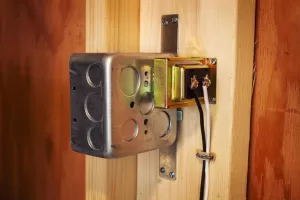
Replacing a Doorbell Transformer: A DIY Guide
November 07 2023 
Inquiry
Global electronic component supplier AMPHEO PTY LTD: Rich inventory for one-stop shopping. Inquire easily, and receive fast, customized solutions and quotes.
QUICK RFQ
ADD TO RFQ LIST
An essential part of any doorbell system is a doorbell transformer, which transforms high-voltage electricity from the electrical system in your house into low-voltage power that can be used to ring the doorbell. A malfunctioning transformer may be the cause of your doorbell's problems. In this blog, we will discuss everything you need to know about doorbell transformers, including their function, common problems, and step-by-step instructions on how to replace them.
What is a Doorbell Transformer?
A doorbell transformer, also called a doorbell power supply, is an electrical device that converts high-voltage AC (alternating current) power from your home's electrical system to a lower-voltage AC power source, usually 16 to 24 volts. Since it shields the doorbell from the higher voltage, this transformation is necessary for the safe and effective operation of your doorbell.
How Doorbell Transformer Works?
- Power Supply: A primary winding connects the doorbell transformer to the home's electrical supply.
- Voltage Transformation: A transformer core connects the primary and secondary windings. Because of the laminated iron construction of the transformer core, the alternating current (AC) of the primary winding induces an AC voltage in the secondary winding.
- Voltage Reduction: The number of turns in the secondary winding differs from that of the primary winding. The secondary voltage is lower than the primary voltage as a result of this discrepancy in turn counts.
- Rectification (Optional): A rectifier circuit, which transforms the AC voltage from the secondary winding into a direct current (DC) voltage, is included in some doorbell transformers. For some kinds of doorbells and chimes, this is required.
- Power Output: The doorbell button and the doorbell chime or bell are then powered by the lower voltage, which can be either AC or DC.
- Doorbell Activation: Pressing the button initiates an electrical circuit that signals the doorbell chime or bell. The sound that we hear then comes from the bell or chime.
Where are Doorbell Transformers Usually Located?
The location of the doorbell transformer varies depending on the construction of your home. However, it is typically found in one of the following places:- Near the Main Electrical Panel: The transformer can be placed in a junction box or mounted on a wall close to the main electrical panel.
- Basement: The transformer in certain homes is usually situated next to the utility room or furnace in the basement.
- Attic: In older homes, the transformer is usually placed close to the electrical wiring in the attic.
How to Wire a Doorbell Transformer?
Wiring a doorbell transformer involves connecting the transformer to the electrical system and the doorbell system. Here are the general steps:- At the main electrical panel, cut the power supply to the doorbell system.
- Find the main and secondary terminals of the transformer.
- Attach the high-voltage electrical system to the primary terminals.
- Link the doorbell system's secondary terminals to it.
- After turning on the power supply, test the doorbell system.
Video related to Doorbell Transformer
Common Signs of a Faulty Doorbell Transformer
- Inoperative Doorbell: A malfunctioning transformer may be the cause if your doorbell does not ring or chime at all.
- Intermittent Doorbell Operation: An intermittent or sporadic doorbell could be an indication that the transformer isn't delivering steady power.
- Weak or Distorted Sound: Insufficient voltage from the transformer may be the cause of a weak or distorted sound coming from your doorbell.
- Continuous or Random Chiming: If a doorbell sounds off without being pressed and keeps chiming, it might be an indication that a transformer isn't working properly.
- Overheating Transformer: If the transformer is hot to the touch, there may be an internal problem that could be dangerous.
- Unusual Noises: The transformer may be having issues with its internal components if it is making buzzing or humming noises.
How to Replace a Doorbell Transformer?
You can do the replacement of a doorbell transformer yourself if you have confidence in your electrical abilities. However, it is always advised to seek professional assistance if you are unsure of yourself or feel uncomfortable working with electrical systems. Here's how to change a doorbell transformer step-by-step: Preparation:- Gather Tools and Materials: Before you begin, gather the necessary tools and materials, including:
- A screwdriver
- Wire strippers
- Electrical tape
- Replacement doorbell transformer (ensure it matches the voltage requirements of your doorbell)
- Safety Precautions: When handling electricity, safety should always come first. Before continuing, turn off the doorbell system's power supply at the main electrical panel.
- Locate and Disconnect the Old Transformer: Locate the doorbell transformer that is currently in place, which is usually placed in a junction box or on a wall. Cut the wires from the terminals of the transformer.
- Remove the Old Transformer: Turn the old transformer off by unscrewing or removing it from its mounting position. It should be carefully taken out of the junction box or wall.
- Install the New Transformer: Install the replacement doorbell transformer firmly in the same spot as the original one. Make sure the alignment is correct for the right wire connections.
- Connect the Wires: Attach the cables from the electrical system in your house to the corresponding terminals on the new transformer. Observe the color-coding scheme as follows: green or bare wire to green terminal (ground), white wire to white terminal (neutral), and black wire to black terminal (hot).
- Secure the Wires: To ensure that the wire connections are shielded from potential contact and are securely fastened, use electrical tape.
- Test the Doorbell: At the main electrical panel, turn on the power supply. Press the doorbell button to make sure it's working correctly.
- Clean Up: Get rid of the outdated doorbell transformer properly. Clear away any debris or tools that were used in the replacement procedure.
Conclusion
Your home is more secure and convenient when your doorbell system is kept up to date. You can maintain the smooth operation of your doorbell system by keeping an eye out for the warning indications of a malfunctioning transformer, knowing the function of the doorbell transformer, and following the comprehensive replacement guide. When handling electrical components, keep in mind that safety should always come first. Getting professional help is always the best course of action if you're unsure or uncomfortable doing electrical work yourself. Having your doorbell ready to alert you and notify visitors will give you peace of mind.FAQs about Doorbell Transformer
Does a Doorbell Need a Transformer? In order to transform the high-voltage electricity from your home's electrical system into the low-voltage power required to operate the doorbell, a transformer is indeed necessary. A transformer is necessary for the doorbell to operate correctly. Can a Doorbell Transformer be Installed in the Wall? It is possible to install a doorbell transformer in the wall. When doing so, it is crucial to adhere to local electrical codes and safety regulations. To guarantee compliance and safety, it is advised to seek the advice of a licensed electrician for proper installation. What Doorbell Transformer Do I Need? The voltage requirements of your particular doorbell system will determine the kind of doorbell transformer you need. The majority of doorbells run on low voltage, usually 16 to 24 volts. To find out what voltage rating your doorbell transformer needs, contact the manufacturer or look up the user manual. What is a Doorbell TransformerHow Doorbell Transformer WorksWhere are Doorbell Transformers Usually LocatedHow to Wire a Doorbell TransformerVideo related to Doorbell TransformerCommon Signs of a Faulty Doorbell TransformerHow to Replace a Doorbell TransformerConclusionFAQs about Doorbell TransformerDoes a Doorbell Need a TransformerCan a Doorbell Transformer be Installed in the WallWhat Doorbell Transformer Do I Need
Related Articles
- ·Stratix 10 VS Stratix V: Which FPGA is Right for Your Next Project?
- ·Intel Xeon Platinum 8454H vs AMD EPYC: Which Reigns Supreme?
- ·A Deep Dive into the AMD EPYC 4564P Processor
- ·MSP430F5438A vs MSP430F5529: A Detailed Analysis of Their Capabilities
- ·Comparing MSP430F6659 and MSP430F5419A: Which One is Right for Your Project?
- ·Exploring the Features of MSP430F5529 and MSP430F5638 Microcontrollers
- ·Demystifying 20 Microcontroller Projects for Beginners
- ·Unveiling the Ultimate Guide to Microcontroller Programming
- ·4680 Battery: Unveiling the Power Potential of the Next-Gen Cell
- ·Exploring the Case Studies on Arduino Applications
Populer Posts
